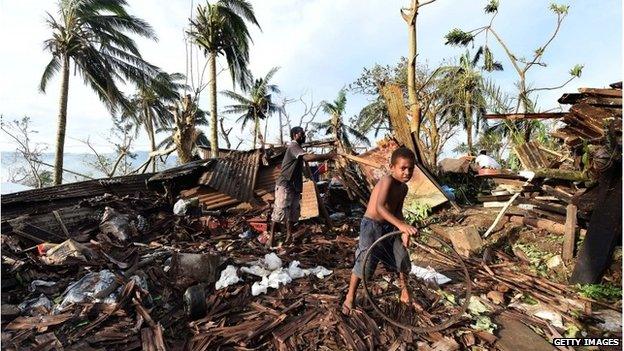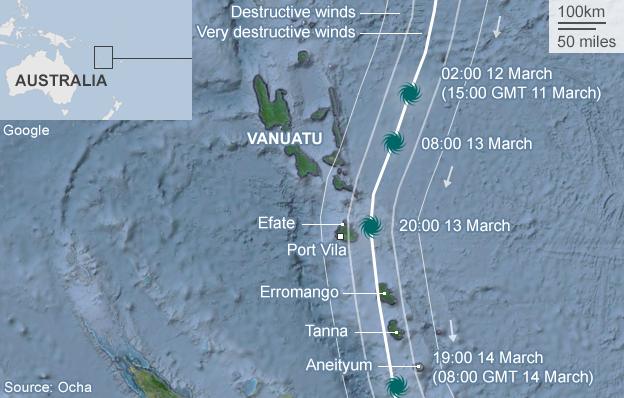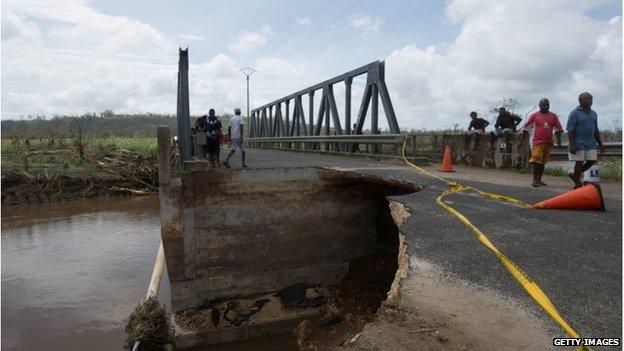Cyclone Pam: UN confirms 24 dead and 3,300 displaced in Vanuatu
- Published
Jon Donnison reports: "The full impact of Cyclone Pam may not be known for several days'
The UN in Vanuatu says 24 people have died and 3,300 are displaced after Cyclone Pam hit the Pacific archipelago early on Saturday.
The UN Disaster Assessment and Coordination team in the capital, Port Vila, said 37 evacuation centres had been set up, but communication with outer islands was still down.
President Baldwin Lonsdale said the storm had "wiped out" all development of recent years.
He called again for international aid.
Of those who died, 11 were from Tafea island, eight from the main island, Efate, and five from Tanna.
The evacuation centres were catering for the many people who had lost their homes, the UN said, adding that the response effort was for now focusing on the capital and Efate.
After aerial assessments of the damage caused by the storm, Shefa remained the only province declared an emergency, the UN said.
Aid began arriving in the storm-hit nation - one of the world's poorest - after flights to Port Vila resumed.
Tropical Cyclone Pam is slowly weakening as it travels towards New Zealand and poses no further threat to Vanuatu or the South Pacific, a report by the UN Office for the Coordination of Humanitarian Affairs (OCHA) says.

The devastation is widespread
The BBC's Jon Donnison, external, in the capital Port Vila, says just about every house there has been damaged and the situation for many people is bleak.
One village chief said there was a desperate need for fresh water supplies.
Cyclone Pam's impact on Vanuatu
24
confirmed fatalities - as of 16 March
-
3,300 people forced to leave their homes
-
19,000 households likely to need emergency food aid based on storm's path
-
37 evacuation centres set up in Torba and Penama provinces and main island of Efate

At the scene: Phil Mercer, BBC News, Port Vila

The sense of devastation is absolutely immense and when you land it doesn't take long for that sense of devastation to increase.
Many family homes have been stripped of their roofs or flattened by very powerful winds and torrential rain.
The air here is very thick with smoke because the cleanup has already begun - the debris is being chopped down, collected and burned. There is a sense here that people will rebuild but it only takes a brief moment in the capital to realise that this rebuilding effort will take many months if not years.
This is a vast archipelago, the population is spread over more than 60 islands and communications are down. It's very difficult for the authorities to have a true picture of the devastation but it's clear the number of dead will increase when communications are made with those outlying areas.
In pictures: Vanuatu devastation

The category five storm, with winds of up to 300km/h (185mph), struck populated areas when it reached Vanuatu early on Saturday local time (+11 GMT).
President Lonsdale, who was attending a disaster preparedness conference in Japan when the storm hit, has appealed for international help, telling AFP news agency: "The humanitarian need is immediate, we need it right now."
Vanuatu President Baldwin Lonsdale: "More than 90% of buildings have been destroyed"
"After all the development we have done for the last couple of years and this big cyclone came and just destroyed all the infrastructure the government has built. Completely destroyed."
Earlier, Mr Lonsdale had described the storm as "a monster", and said he had not been able to confirm that his own family was safe.
The president said climate change had contributed to the disaster, adding that his country had seen changing weather patterns, rising seas and heavier-than-average rain.


An aerial image taken by Care Australia's Tom Perry as he flew into Port Vila shows flattened houses

Aid is being sent from several nations

A major route out of the capital is unusable
In a statement on Sunday, Oxfam Australia said this was "likely to be one of the worst disasters ever seen in the Pacific".
World Vision said it had not been able to contact more than 30 of its staff.
Pam had already caused major damage on other Pacific islands, including Kiribati and the Solomon Islands. Tuvalu declared a state of emergency after the cyclone caused flash floods there.

How poor is Vanuatu?
The UN considers it one of world's least developed countries, external. It has a GDP of $828m (£560.7m) compared to neighbouring Australia's $1.56tn, according to the World Bank, external.
About two-thirds of people make a living from agriculture. Fishing, tourism and offshore financial services are the other main industries.
Australia estimates that about 70% of the population of 250,000 live on remote islands or in rural areas, with few services and limited access to clean drinking water, transport or electricity.
Australia is Vanuatu's main donor, giving A$60.7m (£31.45m: $46.5) in 2013/4, about 60% of total aid.